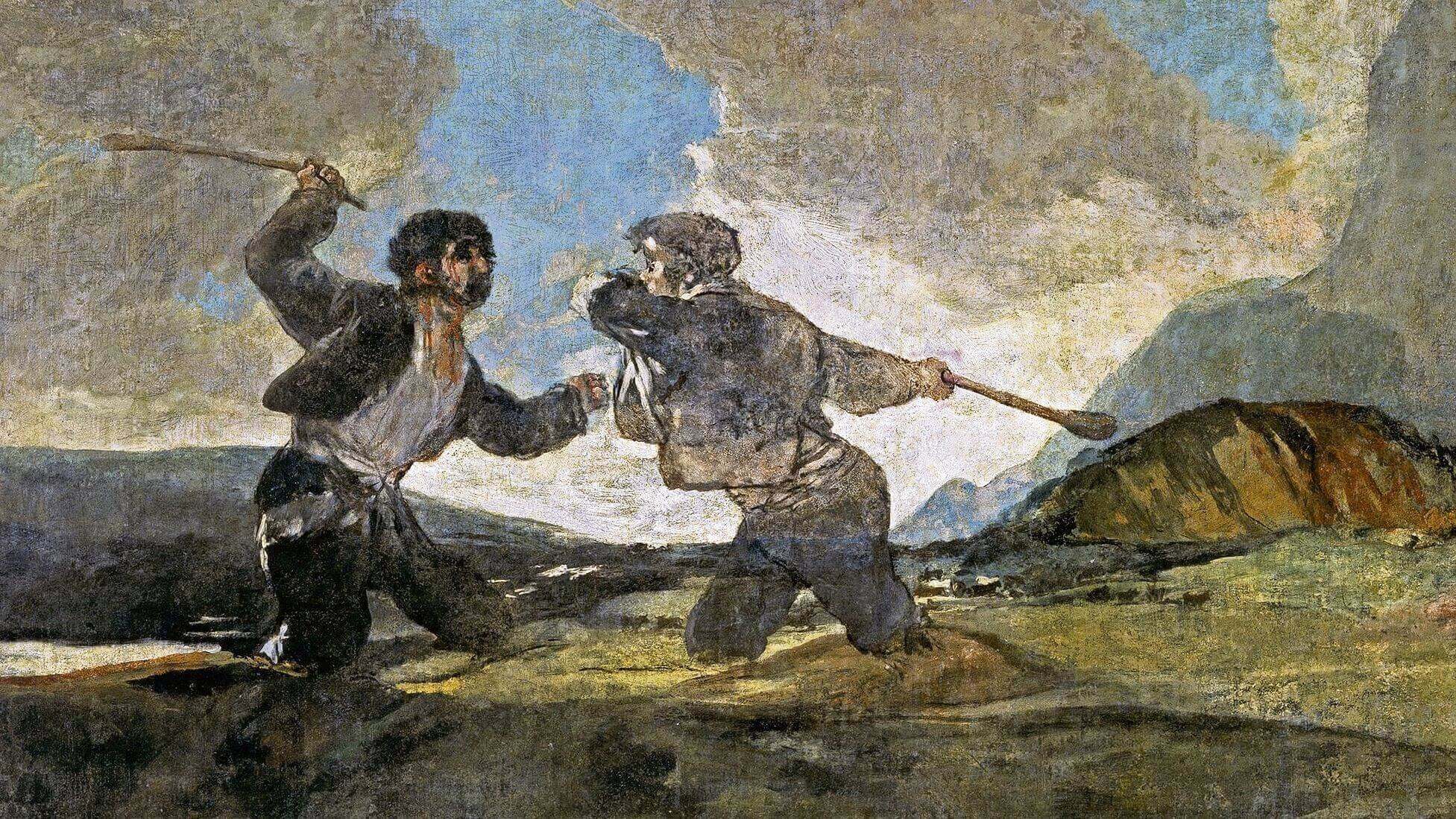Two Men, Fighting
You don’t notice it at first.
The two men are fighting it out with big sticks. One has blood streaming down his face. He lifts his arm to bring his cudgel down hard on his opponent’s head. The other man lifts his arm to protect himself, while reaching back to swing his own club from the side.
We don’t know why they are fighting, or over what. Maybe they are battling for something important. Or perhaps it is a fight started on account of the most trivial slight. There’s no way of telling. But whatever the reason for the fight, there is no heroism here, nothing glorious or uplifting. There is only the dull thud when the sticks meet with bodies, underneath a sky that looks as if it is caught between sunshine and storm.
It is only when you look more closely that you see it: the two men are knee-deep in mud. They are sinking, as if into quicksand.
Forgetting the World
The painting is Men Fighting With Cudgels, by the great Spanish painter Francisco Goya. At the beginning of his book, The Natural Contract, the French philosopher Michel Serres writes about how Goya’s painting provides us with an image of our forgetfulness of the world. We are obsessed by the struggle, the battle between antagonists; we are blind to the place where the struggle plays out.
Serres imagines a group of spectators gambling on the unfolding battle. The bettors put money on one or the other combatant winning—because in a contest like this, somebody must win and somebody must lose. But the antagonists, the bettors and we ourselves don’t notice the quicksand. We don’t realise—until it is too late—that nobody is going to win this fight. The duellists sink into the mud. Nobody wins and everyone loses, including the gamblers, who have staked their fortunes on a winner.
It is an image of philosophy gone wrong. An image of life gone wrong. Aren’t we, Serres asks,
forgetting the world of things themselves, the sand, the water, the mud, the reeds of the marsh? In what quick sands are we, active adversaries and sick voyeurs, floundering side by side? And I who write this, in the solitary peace of dawn? [1]
The Natural Contract is a book about our obsession with the social contracts that we make and remake, our obsession with interpersonal relationships at the expense of all the other relationships in which we are enmeshed. And it is about the natural contracts that bind us, even if we don’t pay attention to them. It is about how the quicksand threatens to engulf us as we squabble for supremacy.
When we forget the world, when we forget the contract that binds us with the world, we risk our own destruction. Obsessed as we are by who is right and who is wrong, the world we share is reduced to ruin. As Michel Foucault (who once shared an office with Serres) once wrote, “the last man, when radiation has finally reduced his last enemy to ashes, will sit down behind some rickety table and begin the trial of the individual responsible.” [2]
On the one hand, Serres’s reading of Goya’s painting is about the environmental crisis that faces us all. But on the other hand, it is also about philosophy. It is about how philosophy, more often than not, is another aspect of this combat, this struggle. And it is about how, in our fascination with winners and losers, we become inattentive to everything else: the clouds, the sky, the distant mountains, and the sucking of the quicksand.
Philosophy as Combat
As Sarah Mattice points out in her book Metaphor and Metaphilosophy, we often think of philosophy in terms of combat. Mattice quotes Charles Dickens: “Philosophers are only men in armour after all.”
Philosophers talk about attacking bad arguments, about fortifying their weak points, so they can become invulnerable, about mounting robust defences of their positions. The whole idea of debate is antagonistic. But being antagonistic. It is about the social contract, the question of who wins and who loses. It may be less muddy and sweaty than the struggle in which Goya’s antagonists are involved, but when imagined as a contest, philosophy is still more or less a process of thwacking your opponent with a metaphorical stick until they fall by the wayside.
This may not always be a bad thing. Maybe some advances do indeed come about through debate and criticism. But it’s probably also true that fewer of them than we imagine come about this way. And as the Zhuangzi puts it, there’s no necessary correlation between being successful in debate, and actually being right:
Once you and I have started arguing, if you win and I lose, then are you really right and am I really wrong? If I win and you lose, then am I really right and are you really wrong? Is one of us right and the other one wrong? Or are both of us right and both of us wrong? [3]
As for Serres, he is a thinker who is famously wary of debate. In an interview with Bruno Latour, he said that “neither debate nor criticism makes any advances, except on the social chessboard and in the conquest of power.” [4] So he, like Sarah Mattice, holds out for the possibility of doing philosophy differently.
But if we do want to do philosophy differently, what are the options? Mattice suggests at least two: philosophy as play, and philosophy as aesthetic experience.
Philosophy as Play
So in what way could you see philosophy as a kind of play? The boundaries between play and combat can sometimes be hard to define precisely: play can be more or less combative; combat can perhaps be more or less playful. But there is substantial a difference in feel between the earnest lumpen combat of Goya’s men with sticks, and the idea of play. Whatever Goya’s antagonists are doing, they are not playing.
For Mattice, one thing that is central to play is that you play not just against others, but also with them. You are playmates, responsive to each other, and to the unfolding game in which you are engaged. And there’s nothing about this ongoing responsiveness that is inherently combative. Even if you do slip into combativeness (as I do when I play Scrabble), the fact that this is play puts limits on the extent of this combativeness, and on the nakedness of our hunger for victory at all costs.

It’s not the winning, we were told as children, it’s the taking part. Even if we feel resentful when we hear this, we also know that it is always at least half true. Sometimes the winning matters. But in a game, winning doesn’t matter at any cost: not to the extent that the desire to win risks breaking the game itself. And there are other reasons that we play, apart from simply winning. We might play for no stakes at all, simply to keep the game going, or to enjoy the to-and-fro between us, or for the delight of play itself.
Thinking about philosophy as play not only brings in new possibilities of delight, but it also allows us to see things that combative metaphors do not. As Ian Bogost points out in his book, Play Anything, play always takes place somewhere: in a playground. Bogost writes that, “A playground is a place where play takes place, and play is a practice of manipulating the things you happen to find in a playground.”[5] This attention to where one is playing changes the dynamic considerably. Think back to Goya’s image. Part of the problem is that the antagonists are forgetful of the playground in which they find themselves. What if they took a breath, decided to get more playful? Then the world would come flooding back in, and they might find different ways to play the situation in which they found themselves.
So engaging in philosophy as a kind of play allows us to ask different questions about what it means to do philosophy. How can I engage creatively with this philosophy? How can I make use of what I find here? How can I test the boundaries of these ideas? Who can I find to play with? And thinking along these lines allows us to think about building different sets of relationships: with playmates, with the places where we have carved our playgrounds to explore.
Philosophy as Aesthetic Experience
The third metaphor Mattice proposes for thinking through philosophy is that of philosophy as a kind of aesthetic experience. Philosophy is not always a battle, nor is it always a way of playing. Instead, it can be an engagement with something artful, the way we might contemplate a painting or a novel.
Mattice says that aesthetic experience involves three components. The first is a work of art: whether that is a painting by Matisse or a philosophy book by Mattice. The second is an artist, somebody who creates a work (although this isn’t necessarily true: we can be aesthetically moved by a landscape, or a goldfinch). And the third component Mattice mentions is a participant, somebody who engages with the artwork. For Mattice, thinking about philosophy as aesthetic experience draws our attention to all kinds of things we might otherwise overlook: the language in which the philosophy expressed, the style of the writing, the way a work of philosophy is embedded in its cultural context, the way it makes us feel.
What would it be like to engage in philosophy as aesthetic experience? It would not be like asking “how can I attack or defend this?” as you would if you treated philosophy as combat. Nor would it be like asking “what can I do with this?”, in the way you might if you treated philosophy as play. Instead, it would be like asking, among other things, “what might this do to me?” It would be a way of entering into a philosophical idea or philosophical work, remaining open to being affected by it, open to being transformed.
Choosing Our Metaphors
Combat, play, or aesthetic experience? Which is the right way to think about philosophy?
If you were an advocate of philosophy of combat, you might look at this list of different ways of engaging with philosophy, and try to decide which is the winner. But why this obsession with winners and losers? Why not play with the possibilities? Why not engage in aesthetic contemplation, open to the possibility of being transformed? Or why not move between these different metaphors to see what they reveal? Why not make it up as you go along, moving from metaphor to metaphor, in the knowledge that there’s no right way of doing philosophy, but that the different approaches will yield different results?
Notes
This piece is dedicated to my students at Parami University, with whom I’ve been exploring all these ideas on our course on the Arts of Argument. And the argument here draws heavily on Sarah Mattice’s Metaphor and Metaphilosophy (Lexington Books 2014). It’s well worth reading.
[1] Michel Serres, The Natural Contract (The University of Michigan Press 1995), p. 2
[2] Michel Foucault (ed. Paul Rabinow), Ethics: Subjectivity and Truth (The New Press 1994), p. 323
[3] Quoted in Readings in Classical Chinese Philosophy, ed Philip J. Ivanhoe and Bryan W Van Norden (Seven Bridges Press 2001), p. 218
[4] Michel Serres and Bruno Latour, Conversations on Science, Culture, and Time (The University of Michigan Press 1995), p. 37
[5] Ian Bogost, Play Anything: The Pleasure of Limits, the Uses of Boredom & The Secret of Games (Basic Books 2016), EPUB.



